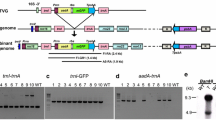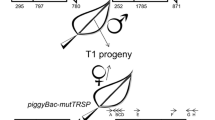Summary
DNA sequences capable of hybridizing with chloroplast DNA have previously been reported to exist in the nuclear genome of higher plants. Here we show that the third intron of the cultivated tomato (Lycopersicon esculentum) nuclear gene Cab-7, which resides on chromosome 10 and which we recently cloned and sequenced, contains two DNA fragments derived from the coding region of the chloroplast gene psbG. The first fragment, 133 bp long, is located at a site 63 bp from the 3′ end of the 833 bp intron. The exact sequence of the 11 nucleotides at the 3′ end of the inserting chloroplast sequence is also found at the 5′ border of the insertion. A small (107 bp) chloroplast DNA fragment is inserted near the middle of the intron, again with the 3′ end of the inserting element (6 bp) duplicated at the 5′ border of the insertion. The second insert is a subfragment of the first insert, and is most likely directly derived from it. The psbG insertion sequence was found to be present in the Cab-7 gene of all tomato species examined but not in species from related genera (e.g. Solanum, Petunia, Nicotiana), suggesting that the original transposition event (chloroplast to nucleus) occurred relatively recently-since the divergence of the genus Lycopersicon from other genera in the family Solanaceae, but before radiation of species in that genus.
Similar content being viewed by others
References
Bernatzky R, Tanksley SD (1986) Majority of random cDNA clones correspond to single loci in the tomato genome. Mol Gen Genet 203:8–14
Doring HP, Starlinger P (1986) Molecular genetics of transposable elements in plants. Annu Rev Genet 20:175–200
Palmer JD (1985) Comparative organization of chloroplast genomes. Annu Rev Genet 19:325–354
Palmer JD, Zamir D (1982) Chloroplast DNA evolution and phylogenetic relationships in Lycopersicon. Proc Natl Acad Sci USA 79:5006–5010
Pichersky E, Bernatzky R, Tanksley SD, Breidenbach RB, Kausch AP, Cashmore AR (1985) Molecular characterization and genetic mapping of two clusters of genes encoding chlorophyll a/b-binding proteins in Lycopersicon esculentum (tomato). Gene 40:247–258
Pichersky E, Hoffman NE, Malik VS, Bernatzky R, Tanksley SD, Szabo L, Cashmore AR (1987a) The tomato Cab-4 and Cab-5 genes encode a second type of CAB polypeptides localized in photosystem II. Plant Mol Biol 9:109–120
Pichersky E, Hoffman NE, Bernatzky R, Piechulla B, Tansley SD, Cashmore AR (1987b) Molecular characterization and genetic mapping of DNA sequences encoding the Type I chlorophyll a/b-binding polypeptide of photosystem I in Lycopersicon esculentum (tomato). Plant Mol Biol 9:205–216
Pichersky E, Tanksley SD, Piechulla B, Stayton M, Dunsmuir P (1988) Nucleotide sequence and chromosomal location of Cab-7, the tomato gene encoding the Type II chlorophyll a/b-binding polypeptide of Photosystem I. Plant Mol Biol 11:69–71
Rich A, Nordheim A, Wang AJ-H (1984) The chemistry and biology of left-handed Z-DNA. Annu Rev Biochem 53:791–846
Scott NS, Timmis JS (1984) Homologies between nuclear and plastid DNA in spinach. Theor Appl Genet 67:279–288
Shinozaki K, Ohme M, Tanaka M, Wakasugi T, Hayashida N, Matsubayashi T, Zaita N, Cunwongse J, Obakata J, Yamaguchi-Shinozaki K, Ohto C, Torazawa K, Meng BY, Sugita M, Deno H, Kamogashira T, Yamada K, Kusuda J, Takaiwa F, Kato A, Tohdon N, Shimoda H, Sugiura M (1986) The complete nucleotide sequence of the tobacco chloroplast genome: its gene organization and expression. EMBO J 5:2043–2049
Slighton JL, Blechl AE, Smithies O (1980) Human fetal Ggamma and Agamma globin genes: complete nucleotide sequences suggest that DNA can be exchanged between these duplicate genes. Cell 21:627–638
Steinmetz AA, Castroviejo M, Sayre RT, Bogorad L (1986) Protein PSII-G. J Biol Chem 261:2485–2488
Stern D, Lonsdale DM (1982) Mitochondrial and chloroplast genomes of maize have a 12-kilobase DNA sequence in common. Nature 299:698–702
Timmis JN, Scott NS (1983) Spinach nuclear and chloroplast DNAs have homologous sequences. Nature 305:65–67
Weeden NF (1981) Genetic and biochemical implications of the endosymbiotic origin of the chloroplast. J Mol Evol 17:133–139
Author information
Authors and Affiliations
Additional information
Communicated by J. Schell
Rights and permissions
About this article
Cite this article
Pichersky, E., Tanksley, S.D. Chloroplast DNA sequences integrated into an intron of a tomato nuclear gene. Mol Gen Genet 215, 65–68 (1988). https://doi.org/10.1007/BF00331304
Received:
Issue Date:
DOI: https://doi.org/10.1007/BF00331304




